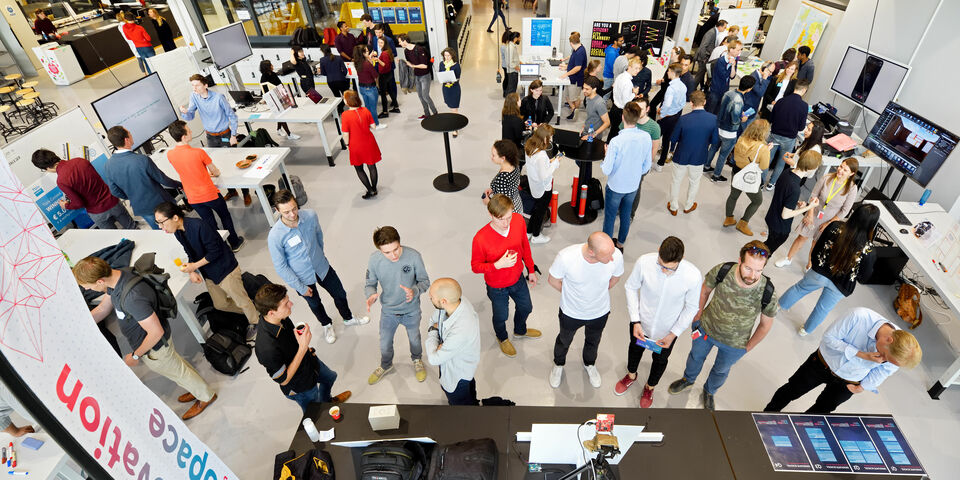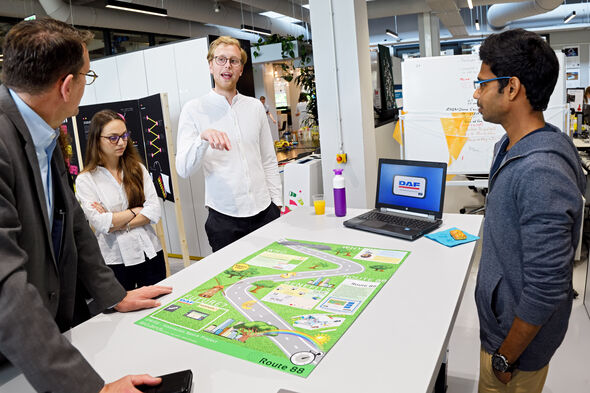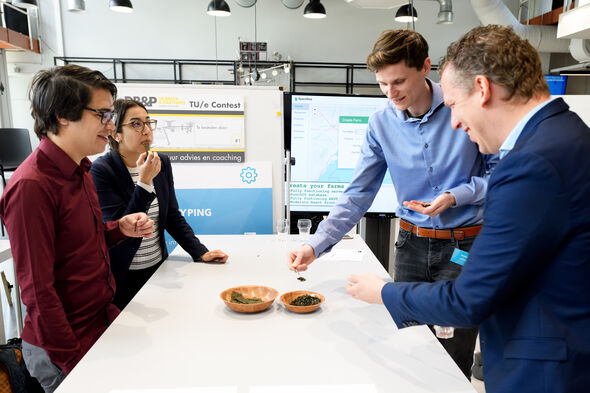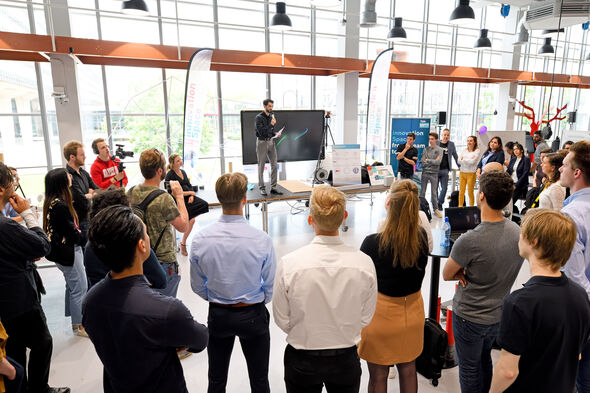ISBEP and ISProject winners make the world a better place
After six months of hard work, students presented their master (ISProject) and bachelor (ISBEP) projects for a jury on June 13th in the TU/e innovation Space. Teams SpaceSea and 3Vacuate won with their ideas for, respectively, more efficient seaweed farming and a better way of evacuating buildings in case of emergency.
The topics of the eighteen participating teams vary greatly. From concrete solutions to reduce CO2 emissions, to creative work that unites technology, art and music. From changing the awkward moment while waiting for the elevator to enabling farmers to grow food easier. Making the world a little better is a popular argument for many project groups. The jury is critical and also tries to motivate the students to make a realistic business model. An idea can be amazing, but how are you going to make money with it? What is your unique selling proposition? And how do you ensure that your competitors do not just copy your concept?
Win-win-wind situation
Route 88 (ISProject), for example, has focused on reducing emissions from trucks. They want to achieve this by enriching a navigation application with wind information to choose the most optimal route. The influence of wind on fuel consumption is considerable. Even if the truck were to take a detour, but encountered much less side wind or head wind, it could save on fuel consumption and therefore also on costs and emissions. Case owner DAF provided the students with some data and support, but it is not the case that this idea was made just for their company. Route 88 team member Sabina Pencheva explains that the team has to come up with a solution for a broader problem, not just for one company. "Route 88 is independent and can try to sell the idea on the entire market." The students have also thought about a revenue model so that both they, the vehicle owners and the drivers can benefit from this new way of driving. Pencheva’s teammate Jan Hidde Lavell called it a nice win-win-wind situation. The jury can also appreciate a small pun like that.
Winners
The winners of both categories have in common that their idea has a positive social outcome. In the category ISBEP 3Vacuate is the winner and for ISProject SpaceSea brings home first place. Perhaps not entirely unexpected after their earlier victory in the ‘Prototyping’ category during the TU/e Contest last week. Their story is clear: the earth is getting fuller and therefore more food is needed. Growing seaweed can help. SpaceSea believes that farming of seaweed should be easier and more efficient and the team wants to use satellite images to make that happen. “This way, the seaweed farmers can keep an eye on their sea farms from a distance and they do not always have to take a boat far into the sea with all kinds of experts on board. That saves a lot of time," Sara Vestergaard Jensen tells the jury in their pitch. Some seaweed can also be tried on site and tastes much better than you might expect.
3Vacuate uses 3D depth sensors to improve evacuation in old buildings. “Through a sensor network and radar technology, it is possible to map exactly where people are located, what the state of being is (for example, by means of their heartrate) and with this data, the most optimal evacuation routes can be determined. We consulted the fire brigade on this topic as well,” Horst Fietje from 3Vacuate elaborates. “There will also be a follow-up. We want an ISBEP team to continue this project next year because it really has potential. A startup is the ultimate goal.” Fietje has experience with those. He is also involved in the XYZ Automotive, a TU/e startup for AxLectric, with which his group won the TU/e Contest in the category of Ideation.
3Vacuate uses 3D depth sensors to improve evacuation in old buildings. “Through a sensor network and radar technology, it is possible to map exactly where people are located, what the state of being is (for example, by means of their heartrate) and with this data, the most optimal evacuation routes can be determined. We consulted the fire brigade on this topic as well,” Horst Fietje from 3Vacuate elaborates. “There will also be a follow-up. We want an ISBEP team to continue this project next year because it really has potential. A startup is the ultimate goal.” Fietje has experience with those. He is also involved in the XYZ Automotive, a TU/e startup for AxLectric, with which his group won the TU/e Contest in the category of Ideation.
The students work together in interdisciplinary teams to come to a more versatile idea. This collaboration makes it attractive for the students. Peter Lakatos from SpaceSea really enjoys participating in ISProject. "We have great team dynamics." His teammate Sven Arends adds that this course is "unlike any other. We are so motivated that we want to continue working during the summer holidays to make a Minimum Viable Product (MVP) and hopefully have it validated by the seaweed farmers at the end of the summer,” Arends adds.
Printing ice in China
Are you still unsure whether a project in TU/e innovation Space is something for you? Assistant Professor Arno Pronk of the department of Built Environment pitched at the end of the presentations to motivate students to take part in the coming semester. He wants to form a team concerning 3D printing of ice. This has been worked on before, but the upcoming project will focus on structures for the Holland Icehouse during the Winter Olympics in Beijing 2022. Preparations for this will start during the coming semester and Pronk is mainly looking for an interdisciplinary team. “In addition to knowledge of architecture, physics, chemistry and mechanical engineering would be very welcome. Then we can better look at material behavior and behavior of the construction as a whole. We are going to China this winter and I hope to bring a good team.”





Discussion